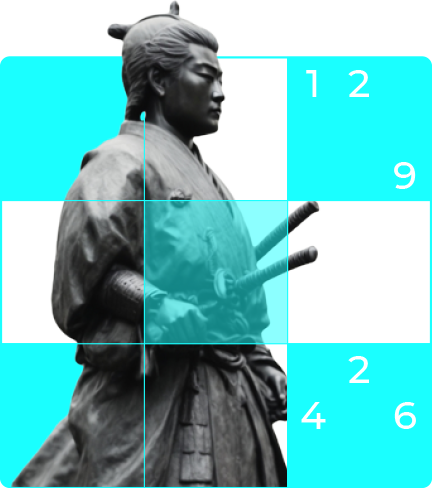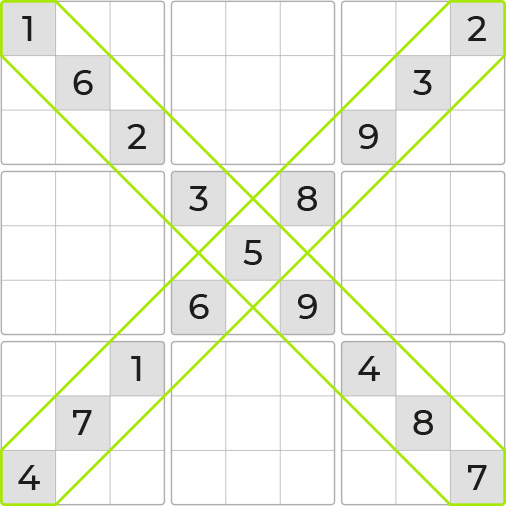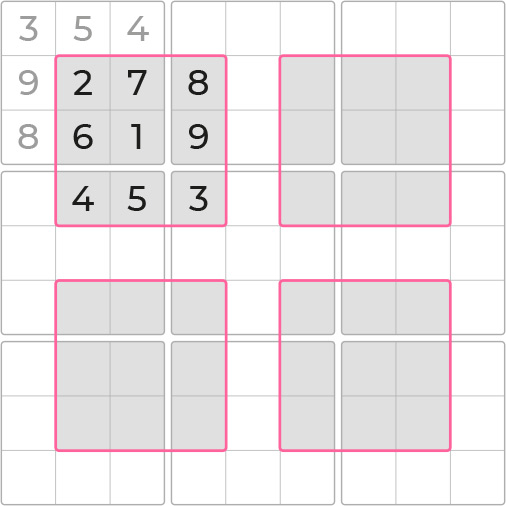how to
play sudoku

Sudoku, as we know it today, has its roots in ancient number puzzles, but the modern version of Sudoku was developed in the late 20th century. It became popular in Japan in the 1980s after it was introduced by the puzzle company Nikoli. They introduced the name “Sudoku,” which is short for “Sūji wa dokushin ni kagiru,” meaning “the numbers must be single” or “the numbers must occur only once.” In Japanese, “Su” means number, and “Doku” means single or solitary. The name “Sudoku” endured, but it only became a global phenomenon in early 2000s. The puzzle started gaining traction in the Western world.
People all over the world now play Sudoku as a form of entertainment, and also for the proven mental benefits. Among others, Sudoku helps to improve your memory and concentration, reduces the risk of Alzheimer’s, and can even contribute to reducing anxiety.
The basic rules
of Sudoku
Sudoku is a puzzle game where you fill in numbers on a 9×9 grid, divided into nine smaller 3×3 blocks. The goal is to fill the entire grid with numbers from 1 to 9, respecting the following basic rules:
rows
Each number from 1 to 9 can appear only once in each row.

columns
Each number from 1 to 9 can appear only once in each column.

blocks
Each number from 1 to 9 can appear only once in each 3×3 block.

steps to play
sudoku
Scan the board: Start by scanning the board to see which numbers are already placed, what placed numbers occur most frequently, and which blocks hold most of the numbers. This gives you an idea of which numbers you might be able to fill in the empty cells.
Look for certainties: Check if there are rows, columns, or blocks where you can confidently place a number because it’s the only possibility left.
Elimination: If you’re unsure about which number should go in a particular cell, look at the other numbers in the row, column, and 3×3 block. By elimination, you can often determine which numbers are possible candidates for a specific cell.
Make notes: If you’re unsure about which number should go in a cell, you can add small numbers, called notes, in that same cell as possible options. Later, as you gather more information, you can revisit these possible candidates.
Keep going: Continue placing numbers you’re certain about and use elimination to determine other numbers. Sometimes, you don’t see the solution immediately, however, all Sudoku games within Sudoku X have only one possible solution and can be solved through logical reasoning. No guessing needed, be patient, and keep going.
Check your work: Once you think you’re done, go through each row, column, and 3×3 block to ensure you haven’t broken any of the basic rules.
Help offered: Fill notes
In our game board we have included a neat feature that allows you to auto-fill all possible candidates, saving time and allowing you to focus on solving rather than taking notes. As Sudoku X we love to support new Sudoku enthusiasts. As such, this feature is made readily available for Beginners and Easy games. Beyond these levels, you can continue to use this feature consuming a brain coin.
Different
Levels Explained
The difficulty level of a Sudoku puzzle is typically determined by the number of given clues, the placement of these clues, and the solving techniques and the number of steps required to complete the puzzle. Next is a breakdown of the differences in difficulty levels:
BEGINNER:
Our Beginner level Sudoku boards are designed for those new to Sudoku. Typically, these boards contain many clues and only require you to know two placement techniques to solve: Last Free Cell and Last Possible Number. The numbers of steps required to complete the board is small.
EASY:
Our Easy level boards are a step up compared to the Beginner’s. You will encounter fewer clues (approximately 36) and require more steps to complete the Sudoku game. In addition to the placement techniques required at the Beginner level, you need to familiarize yourself with the Single Possible Position technique. Try playing this level without using notes as well.
MEDIUM:
With our Medium level boards, you will face a challenge in applying what you have learned so far. To solve the Sudoku games, you will need to master all placement techniques introduced in our Beginner and Easy level boards. What makes these games harder to solve is the reduced number of hints (approximately 27). You might find it helpful to start using notes ;-)
HARD:
Don’t underestimate our Hard level boards. All basic elimination techniques are introduced, including techniques like Naked Pairs, Pointing Pairs, and Box-Line Reduction. What makes these games harder to solve is the reduced number of hints and the necessity of applying multiple techniques. Keep an eye out for our Windoku boards! From the Hard difficulty level and up, it’s not just the four obvious constraints you need to consider. Learn more by visiting our Sudoku Academy.
EXPERT:
With our Expert level games, we introduce more advanced elimination techniques. These techniques complement the ones you have already mastered while playing Hard level games. Examples include X-Wing, Remote Pairs, variations of short chains like Skyscraper, Y-Wing and more. Solving our Expert games demands a decent amount of solving skills and proficiency. More steps are required to solve compared to Hard level games.
MASTER:
Our Master level games demand true mastery. Reserved for the hardcore Sudoku solvers amongst you, these games cannot be taken lightly and certainly aren’t for the faint-hearted. They require more advanced elimination techniques such as: Swordfish, various Rectangles, XYZ-Wing, multiple Chaining strategies, and more. Don’t get discouraged if you can’t complete a Master level game right away. Practice, as with everything, is key. Best of luck!
variations
Different Sudoku
Variations
We offer various Sudoku game variations all requiring their own solving logic. Besides the Classic game we offer the Sudoku X and Windoku variants.

Sudoku X
(Diagonal Sudoku):
In addition to the Basic Rules of Classic Sudoku, each number from 1 to 9 must also appear only once in each of the two main diagonals. This means that, along with the rows, columns, and 3×3 blocks, the two diagonals (from top-left to bottom-right and from top-right to bottom-left) should not have any repeated numbers.
These additional constraints make Sudoku X a bit more challenging than the Classic version because you have to keep the diagonals in mind while solving. The visual “X” formed by the two diagonals gives this variant its name.

Windoku:
This Sudoku puzzle uses a standard 9×9 grid, just like Sudoku Classic. However, in addition to the standard nine 3×3 blocks, there are four extra regions located in the center of the grid. These extra regions, typically marked by shaded cells, also contains nine cells each.
Rules:
- Each row must contain each number from 1 to 9 exactly once.
- Each column must contain each number from 1 to 9 exactly once.
- Each of the standard 3×3 blocks must contain each number from 1 to 9 exactly once.
- Each of the four extra regions in the center must also contain each number from 1 to 9 exactly once.
The added challenge in this variant comes from the extra regions introducing more constraints to the puzzle. More constraints typically means fewer starting hints. While solving, you have to keep in mind not only the rows, columns, and standard 3×3 blocks but also these additional regions. This can make the puzzle more challenging compared to the Classic version.
The extra regions are considered 4 ‘Windows’ within the grid giving the variant its name. Windoku is also referred to as Hyper Sudoku.
enjoy
